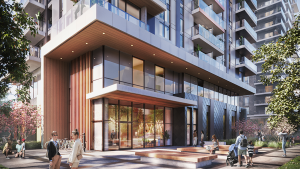One of Vancouver’s fastest growing areas is looking to level up under the surface.
The City of Vancouver is densifying the Cambie corridor, a wide swath of land primarily occupied by single-family housing that stretches from West 16th Avenue to the Fraser River. The reconfiguration of the corridor will span 30 years, but before changes happen above ground, infrastructure below the surface will need an upgrade.
“We’re primarily addressing water, sewers and green infrastructure,” said City of Vancouver general manager of engineering Jerry Dobrovolny.
“We want growth to pay for growth in the city, but it’s been happening at such a rapid pace we haven’t been able to keep up with funding infrastructure.”
While the entire city has experienced growth, Dobrovolny said, the need is most acute in the Cambie corridor which has exploded in population since the Canada Line and neighbourhood hubs such as the Oakridge Mall were built.
“The Canada Line played a significant role in indicating the need for density. The corridor has beautiful neighbourhoods with lots of green space, and a train that lets you jump off downtown or at the airport. It’s part of the regional growth strategy. But with the Canada Line and with tremendous demand for housing in the city, it ramped up exponentially,” he said.
“We’re looking at 50,000 more people in the Cambie corridor. From the surface it’s an ideal location to add density, but below the surface the utilities were built for single family homes. We don’t have anywhere near the infrastructure we need for an increase in population of 50,000 people.”
Dobrovolny pointed to the corridor’s potable water system, drainage and sanitary system as key priorities that “need the most attention.”
“We’ve developed a holistic strategy for water. The Cambie corridor has a high water table with operating wells, and we’re looking for better ways to manage groundwater and to see if grey water can be used in buildings,” he said.
While the infrastructure is being upgraded, it is not being replaced wholesale, Dobrovolny said.
“We’re not replacing every pipe, and we’re certainly looking at green infrastructure as a way to extend the life of the existing system,” he said.
But the current infrastructure was built in the 1950s and ‘60s to serve single family homes and is not optimal for mitigation of newer problems such as climate change.
“Climate change is real and it’s here now. We’re already seeing the effects with intense storms. Having more rainwater retention allows us to use infrastructure longer,” Dobrovolny said.
The City of Vancouver will soon consider a report from the engineering and planning department recommending a new city-wide utilities development cost levy (DCL) to recover $547 million from new development until 2026. The report estimates the cost of capital projects for the 2010-2026 period is $1.03 billion, with sanitary system upgrades at $389 million, rainwater and drainage at $612 million and water system upgrades at $39 million.
“This levy applies to the whole city, but the need is most acute in the Cambie corridor,” Dobrovolny said. “DCLs work by everyone paying, then the project list comes in and we update the list based on growth areas. So roughly half is going to the corridor, and half to the rest of the city.”
The new DCL rates, if approved, would go into effect in September, though the report recommends the Utilities DCL be waived for rental market housing until 2020 on an interim basis with a review by staff next year.
The report also confirms the Utilities Servicing Plan for Phase 3 of the Cambie corridor. Vancouver City Council approved Phase 3 in May 2018. The utilities servicing plan includes “pre-zoning” of townhouse areas and requirements for onsite rainwater and groundwater management.
Dobrovolny said the scale of the plan is such that half of the infrastructure work will be done by city staff, and half by outside contractors.
“We think this would be of the scale to attract larger-scale and national contractors. That’s part of our delivery, not just the schedule, but also how we bundle contracts and what methodologies we use,” he said.
“It’s all being reviewed. It’s a very substantial program that will route out over the next two years, and be delivered over the next eight to 20 years.”











Recent Comments
comments for this post are closed